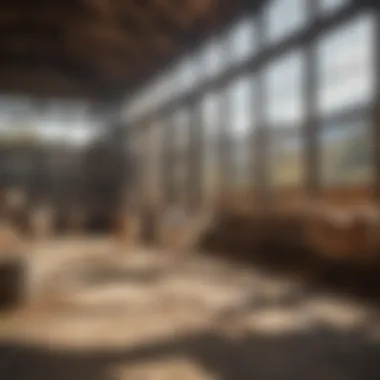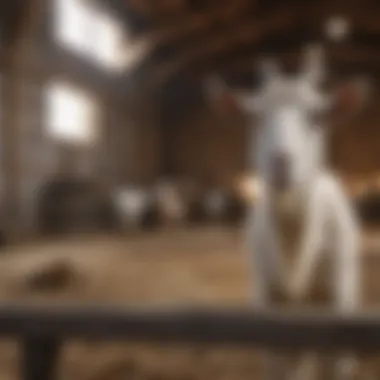Ultimate Guide to Goat Barns: Buying and Building Insights


Intro
When considering goat ownership, the importance of a suitable goat barn cannot be overstated. A well-designed barn provides shelter, safety, and a comfortable living environment for goats. With an increasing interest in goat farming, understanding the market and options for goat barns is essential. This guide aims to equip potential buyers with valuable knowledge about selecting or building the right barn for their goats.
The following sections will cover various aspects related to goat barns, focusing on key features that ensure goat welfare, analysis of styles tailored for different climates, and cost factors that play a crucial role in the decision-making process. Additionally, insights on best practices in goat husbandry will be discussed, ensuring readers make informed choices for the benefit of their animals.
Grooming Techniques
Grooming is crucial in maintaining the overall health and appearance of goats. It involves basic practices that keep the goats clean while also enhancing their well-being. Knowing the right techniques and tools can simplify the grooming process.
Basic Grooming Tools
The following tools are essential for effective goat grooming:
- Rubber Curry Comb: Helps to remove loose hair and dirt from the coat.
- Flea Comb: Effective for removing pests.
- Hoof Trimmers: Important for maintaining hoof health.
- Shears: Useful for trimming thick fur, especially in certain breeds.
Step-by-Step Grooming Guides
- Start with a Calm Environment: Ensure the goat is calm before grooming.
- Begin with the Body: Use the rubber curry comb to loosen dirt from the coat, working from neck to tail.
- Check the Hooves: Lift each hoof and inspect them for any signs of disease or overgrowth.
- Final Touches: Inspect the coat for any remaining dirt and finish with a gentle brush.
Breed-Specific Grooming Needs
Some goat breeds require unique grooming care. For instance, Angora goats need more frequent shearing due to their long, thick fiber, while Nigerian Dwarfs may require less intensive grooming. Familiarity with the particular needs of each breed is important for successful maintenance.
Health and Wellness
The health of goats is directly linked to various factors, including diet, regular veterinary check-ups, and attention to common health issues.
Nutrition and Diet Tips
A balanced diet is vital for goats. Key components include:
- Hay: High-quality hay should be the foundation of their diet.
- Grain: Limited amounts of grain can be provided, depending on age and health status.
- Minerals: Ensure access to suitable mineral supplements.
Common Health Issues and Solutions
Common health problems among goats include:
- Bloat: Can result from sudden changes in diet. Monitor and consult with a vet if necessary.
- Foot Rot: Regular hoof maintenance can prevent this disease.
Importance of Regular Check-Ups
Regular veterinary visits are critical for preventive care, vaccinations, and timely interventions for any emerging issues.
Training and Behavior
Understanding goat behavior and training can enhance the owner-animal relationship. Basic commands can contribute to a more manageable herd.
Basic Training Commands
Familiar commands include:
- Come: Useful for calling goats to you.
- Stay: Important for controlling goats in open areas.
Understanding Common Behavioral Issues
Some goats may display behavioral issues like aggression or anxiety. Understanding the triggers can aid in addressing these behaviors.
Techniques for Effective Training
Consistent and gentle reinforcement methods are essential. Positive reinforcement, such as treats or praise, can improve compliance.
Product Reviews
When selecting grooming or health products, consumers benefit from reviews and comparisons.
Comparison of Grooming Tools


Evaluate tools based on durability, effectiveness, and user feedback. For instance, some combs may perform better on specific coat types.
Best Pet Products for Health
Review various supplements and health products to find the most beneficial for goat care. Reading user experiences often helps in making informed choices.
Review of Training Aids
Helpful training tools, such as clickers or treat dispensers, can be effective in reinforcing positive behavior among goats.
Community Insights
Engaging with fellow goat owners can provide valuable familiarity with techniques and experiences.
User-Submitted Tips and Tricks
Many goat owners share unique approaches to grooming or training. Participating in forums or local clubs can yield practical suggestions.
Real-Life Grooming Experiences
Reading about other goat owners’ experiences can highlight common challenges and solutions encountered during grooming.
Expert Guest Contributions
Inviting experts for guest articles can provide deeper insights into best practices in goat care, enriching the knowledge base available to goat owners.
Prolusion to Goat Barns
Goat barns play a crucial role in the well-being and productivity of goat farming. Allocating appropriate space and shelter for these animals is vital not only for their comfort but also for their health and productivity. In this section, we will discuss the primary reasons for having goat barns, the different types of goats that require these facilities, and how these structures contribute to the overall management of goat husbandry.
Importance of Goat Barns
Understanding the importance of goat barns is foundational for effective goat management. Goats need protection from harsh weather conditions such as extreme heat, cold, or rain. An adequately designed barn provides shelter from these elements, ensuring that goats remain dry, warm, and hydrated. Furthermore, barns serve as a safe space to keep goats safe from predators. This security measures are crucial, especially in rural areas where wild animals might pose a threat.
Moreover, goat barns promote good herd health. They allow for better hygiene management, reducing the chances of disease transmission between animals. A well-ventilated barn can also reduce humidity and the risk of respiratory issues, which are common in goats. Thus, investing in a proper goat barn not only enhances the living conditions for the animals but also improves overall productivity through better health.
Types of Goats Requiring Barns
Different breeds of goats have specific needs when it comes to shelter. Some goats, like the Nubian or Boer, are more adaptable to varied conditions, but they still require proper housing to thrive. Other breeds, such as the Saanen or Toggenburg, may have different sensitivities to temperature changes.
In addition, pregnant or lactating goats need a quiet, calm space. Nesting and birthing areas are essential. Thus, the barn's design should consider these variations among breeds to ensure that all goats feel secure and supported.
- Dairy goats: Require barns that provide ample space and specific areas for milking, which necessitate cleanliness.
- Meat goats: Often need open space for grazing, but a barn that keeps them sheltered during bad weather is equally important.
- Fiber goats: These types may have unique needs related to coating maintenance and require added ventilation to keep them comfortable.
Understanding the specific needs of various goat breeds can significantly enhance the investment in a goat barn, ensuring it meets their diverse requirements. Goats are not just livestock; they require intelligent and compassionate management in their housing situations.
Features to Consider When Buying a Goat Barn
When selecting a goat barn, several features play a crucial role in ensuring the well-being of your animals. Understanding these elements can lead to a healthier and more productive living environment for goats. Proper consideration will also aid in making a wise investment. Below are some essential features to keep in mind when purchasing or building a barn.
Size and Space Requirements
Each goat breed has different spatial needs. Larger breeds, such as Nubian goats, require more space compared to smaller ones like Nigerian Dwarfs. An adequate barn should provide sufficient room for the goats to move freely, lie down comfortably, and avoid stress. Generally, aim for at least 15 to 20 square feet per adult goat inside the barn. Additionally, outdoor space for grazing and exercise is important. The layout should allow for separate areas for feeding, resting, and exercising.
Ventilation and Airflow
Good ventilation is vital for maintaining air quality within the barn. Proper airflow helps to remove moisture, odors, and harmful ammonia that can build up from goat waste. Lack of ventilation can lead to respiratory issues among the herd. It is advisable to incorporate windows, vents, and strategic design features that promote airflow without creating cold drafts during winter months. Natural ventilation, combined with fans if necessary, can significantly enhance the living conditions for your goats.
Insulation Considerations
Insulating the barn is an important aspect, especially in areas with extreme temperature fluctuations. Goats are sensitive to both heat and cold. Proper insulation helps to regulate internal temperatures, creating a more stable environment. Materials such as foam boards, cellulose, or fiberglass can be effective in maintaining warmth during colder months while reflecting heat during summer. Consider the local climate when planning insulation needs.
Flooring Options
Flooring choices can greatly impact goat health and comfort. The floor should be durable, easy to clean, and slip-resistant. Common options include concrete, rubber mats, or gravel. Each material has its pros and cons. Concrete is long-lasting but may be hard on the goats’ feet. Rubber mats offer cushioning but might require more frequent cleaning. Evaluate the conditions of your region and the specific needs of your goats in choosing the best flooring.
Ease of Access


Accessibility is often overlooked but is key for effective care. The barn should allow for easy access to all areas for feeding, cleaning, and veterinary checks. Features such as wide aisles, appropriate door sizes, and designated areas for storage can facilitate daily tasks. An easy-to-navigate layout ensures that all activities can be performed efficiently, reducing stress on both the caretaker and the goats.
It is crucial to plan the design of the barn keeping access in mind to enhance management efficiency and goat well-being.
Understanding these features can guide you towards a suitable goat barn, whether you are purchasing a prefab unit or constructing a custom one. Remember to prioritize the comfort and safety of the goats in every decision.
Types of Goat Barns Available
Understanding the types of goat barns available is crucial for any goat owner or aspiring farmer. Each type of barn comes with distinct advantages and is suited for different situations and requirements. Factors such as climate, herd size, and budget all play significant roles in choosing the right barn. By knowing what options are available, one can better meet the needs of the goats while optimizing their operation.
Prefab Goat Barns
Prefab goat barns are prefabricated structures that can be assembled quickly on-site. These barns often come in various sizes and designs to suit different goat breeds and management styles. One advantage of a prefab barn is its ease of installation. They typically come with all necessary components ready for set-up. This makes them ideal for new goat owners who may not have the experience to design and construct a barn from scratch. Additionally, prefab barns can be more cost-effective than custom options, as mass production reduces material and labor costs.
Some common features of prefab barns include:
- Durability: Many prefabricated structures use high-quality materials designed to withstand the elements.
- Variety: Buyers can choose from a range of sizes and designs to fit their specific needs, whether that is for a small hobby farm or a larger commercial operation.
- Customization: While they are pre-built, some providers allow for customization options, such as additional windows, doors, or interior layouts.
While convenient, it is important to assess whether a prefab barn meets all your specific requirements before making a purchase.
Custom-Built Goat Barns
Custom-built goat barns provide the opportunity for complete control over design and functionality. This type of barn is ideal for those with specific needs based on their operational style or the behavior of their goats. Builders can incorporate elements like specialized flooring, unique venting systems, or additional storage areas.
The main benefits of custom-built barns include:
- Tailored Design: Owners can create a layout that best suits their goat management practices. This includes choosing the materials, sizes, and interior setups that will optimize goat well-being.
- Sustainability: Buyers can choose environmentally-friendly materials, contributing to a more sustainable farming operation.
- Future Expansion: Custom barns can be designed to allow for future modifications or expansions as the goat farm grows.
However, custom-built barns typically come at a higher upfront cost and may take longer to construct compared to prefab options. Planning and budgeting are essential to ensure the project stays on track and meets expectations.
Portable Goat Shelters
For those who require flexibility, portable goat shelters are an excellent solution. These shelters can be moved easily as the goats graze or as environmental conditions change. They are particularly useful for rotational grazing practices.
Key characteristics of portable goat shelters include:
- Mobility: Owners can relocate the shelter, allowing for fresh grazing areas while ensuring the goats have protection without damaging specific land areas.
- Lightweight Materials: Many portable shelters are made from lightweight components, making them easy to transport.
- Simplicity: They offer a straightforward solution for short-term needs without the commitment of a permanent structure.
To summarize, understanding the types of goat barns available not only allows a goat owner to select the appropriate shelter but also greatly influences the well-being of the herd and overall productivity. The ideal choice will depend on many factors, including the goals of the farming operation, budget availability, and the specific needs of the goats.
"Choosing the proper type of goat barn is not just about shelter but about creating a healthy environment for growth and productivity."
Factors Influencing the Cost of Goat Barns
Understanding the factors that influence the cost of goat barns is crucial for potential buyers. Making a well-informed decision requires knowledge of different elements that contribute to overall expenditure. Buyers can streamline their budgeting process and ensure they select a barn that meets both financial and practical needs by knowing these factors.
Material Costs
Material costs are one of the most significant aspects affecting the overall price of a goat barn. Different materials carry different price tags and durability. Common materials include wood, metal, and composite options.
- Wooden Barns: These often offer aesthetic appeal. However, their cost can fluctuate based on the type of wood used. Cedar, for example, is more expensive but highly resistant to pests.
- Metal Structures: Steel or galvanized materials tend to be more durable and easier to maintain over time. Initially, their cost might be higher, but they often last longer than wooden barns.
- Composite Materials: These can provide a balance between cost and durability but might not be as readily available as wood or metal.
Ultimately, selecting the right materials depends on the specific needs for insulation, durability, and aesthetics.
Labor Expenses
Labor expenses can significantly impact the total cost of constructing a goat barn. These costs will vary based on location and the complexity of the barn design. For example, if you opt for a custom-built barn, you should expect increased labor costs due to the unique designs and requirements involved.
- DIY Construction: Undertaking the project yourself can minimize labor costs. However, this approach requires a skill set and time investment.
- Hiring Professionals: While hiring professionals ensures quality workmanship, it adds to upfront costs. Researching local labor rates will give you a clearer picture of what to expect.
- Post-Construction Improvements: Consider potential labor costs for ongoing maintenance or renovations that may take place after the barn is built.
Understanding these labor considerations will help you budget for both initial construction and future requirements.
Location and Site Preparation
The location of your goat barn plays an essential role in determining costs. Different geographical areas have varying land prices, which will impact overall expenses.
- Site Preparation: Preparing the land can add to costs. This may include grading, clearing trees, or improving drainage systems. Proper site preparation not only helps reduce future maintenance but also ensures the safety and well-being of your goats.
- Accessibility to Resources: Consider the distance to suppliers when buying construction materials. Costs may accumulate if suppliers are far away, affecting your choosing of materials.
- Local Regulations: Some regions may have specific zoning and building regulations that can influence costs. This can range from permits to mandatory inspections.


It's critical to gather estimates for labor, materials, and site work before committing to purchasing a goat barn.
By grasping the factors influencing costs, potential buyers can make strategic choices that align with their financial and livestock care goals.
Assessing Used Goat Barns
Assessing used goat barns is a key component of this article as it offers an alternative to building new structures from scratch. This approach can be both economical and efficient, especially for those who seek to expand their operations or to start with a lower initial investment. However, the buying process comes with considerations that must be carefully navigated to ensure the welfare of the goats will not be compromised. Understanding what to look for in a used barn is essential not only to assess value but also to ensure safety, hygiene, and durability for animal habitation.
Inspection Checklist
When considering a used goat barn, an inspection checklist serves as a practical guide to ensure that all critical elements are addressed. Here are important factors to evaluate:
- Structural Integrity: Look at pillars, beams, and overall framework. Any signs of sagging or cracking indicate structural issues.
- Roof Condition: Check for leaks, missing shingles, or significant wear. A good roof is essential for protecting goats from rain and snow.
- Flooring: Evaluate the barn floor for damage or wear. The flooring should be solid and easy to clean to promote goat health.
- Ventilation: Ensure that the barn has adequate windows or vents for airflow. This is vital for maintaining air quality.
- Pests and Rodents: Inspect for signs of pest infestation. Signs such as droppings or nesting indicate potential health hazards.
- Water and Drainage: Check the condition of water sources and drainage systems. Poor drainage can lead to standing water, which contributes to illnesses.
- Accessibility: Ensure easy access for feeding and cleaning.
By following this checklist, buyers can protect their investment and assure a safe environment for their goats.
Renovation Potential
Once a used goat barn is evaluated, understanding its renovation potential is the next step. This aspect can often determine whether a barn is a viable option or not. Important considerations include:
- Cost of Renovation: Assess what needs to be repaired or updated. This includes structural improvements, plumbing needs, and environmental upgrades like ventilation systems.
- Local Regulations: Research local zoning laws or building codes that may impact renovation plans. Certain areas may have specific requirements.
- Customizability: Determine if the barn layout can accommodate changes to better serve goat needs. Flexibility in design can lead to more efficient use of space.
- Material Quality: The materials used in the original construction will affect renovation efforts. Durable materials will reduce the need for frequent replacements.
Renovating a used barn can significantly extend its life and improve conditions for goats, but careful planning is essential.
Considering these factors allows individuals to make informed decisions regarding the potential of a used goat barn. It can ultimately lead to enhanced animal welfare and improve operational efficiency.
Best Practices for Goat Barn Maintenance
Maintaining a goat barn is essential for the health and well-being of the animals. Proper maintenance practices ensure that the environment remains safe, clean, and comfortable, which directly affects the goats' productivity and overall health. Implementing best practices in maintenance not only helps in meeting regulatory standards but also reduces long-term costs associated with repairs and healthcare. Regular attention to cleanliness and pest control can prevent disease outbreaks and promote a peaceful living atmosphere for the goats.
Regular Cleaning and Hygiene
A clean barn is foundational to good goat husbandry. Regular cleaning routines should be established to maintain hygiene. It involves removing manure, bedding, and any uneaten feed. Manure can accumulate quickly and lead to unpleasant odors or health issues.
The cleaning process should include:
- Daily Removal: Manure should be picked up at least once a day to minimize odor and health risks.
- Deep Cleaning: This should occur weekly or bi-weekly. Scrubbing surfaces, disinfecting, and replacing bedding are crucial steps.
- Water Access: Ensure water troughs are cleaned frequently to prevent algae growth and contamination.
By adhering to these practices, you ensure not just the cleanliness of the barn but also the happiness and health of the goats.
Proper hygiene minimizes disease risks, which can save significant veterinary expenses and enhance goat productivity.
Pest Control Strategies
Pests pose a real threat to goat health and barn integrity. A proactive approach to pest management should be in place to control infestations before they escalate.
Key strategies include:
- Regular Inspections: Inspect the barn regularly for signs of pests such as droppings, webs, or nests.
- Proper Sealing: Ensure that openings that allow pests to enter are sealed. This could be gaps in walls or around doors and windows.
- Natural Deterrents: Use natural deterrents like diatomaceous earth to target unwanted pests. This is safe for livestock and can be effective against insects.
- Trap Use: Employ traps strategically around the barn to monitor pest levels and capture rodents without much effort.
Taking these steps not only protects the goats but also creates a more pleasant environment for everyone involved.
Conclusory Thoughts on Goat Barn Acquisitions
Buying or building a goat barn is an investment that goes beyond the structure itself. It is a crucial aspect of ensuring the health, safety, and productivity of the goats. As we move towards a more sustainable future in agriculture, understanding the subtleties of goat barn acquisitions becomes even more essential.
The choice of barn can affect not only the goats’ welfare but also the overall operational efficiency. Considerations such as barn size, ventilation, and maintenance affect not just the immediate comfort of the animals but also the longevity and costs associated with the barn in the long run. There is also a growing importance on environmentally friendly materials and energy-efficient designs as agricultural practices progress.
Future Trends in Goat Barn Construction
In recent years, we have seen a shift in the design and construction of goat barns to incorporate innovative materials and technologies. Trends indicate that sustainable building practices will dominate the market. Many builders are now focused on using recycled or sustainable materials, as well as implementing solar energy solutions for lighting and heating.
Moreover, smart barn technologies are beginning to take hold. Features such as automated feeding systems, climate control sensors, and health monitoring devices are becoming more common. This technology aims to improve both the welfare of the goats and streamline operations. As these innovations become more accessible and affordable, they will likely become standard in barn construction.
Encouragement for Informed Decisions
Taking the time to research and evaluate options is paramount. An informed decision regarding goat barns not only enhances the quality of life for the goats but also protects the owner's investment. Resources include consulting with professionals, visiting existing barns, and connecting with fellow goat owners for first-hand insights.
Ultimately, a well-informed choice leads to a barn that meets the needs of the animals and the owner’s operational goals. This increases satisfaction and profitability.
In summary, the decision to acquire a goat barn should not be rushed.
An informed decision today can ensure a healthy and productive environment for both goats and their caretakers tomorrow.







